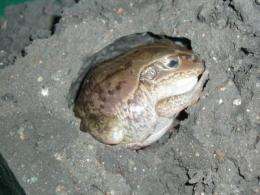Super-sleepers could help super-sizers!

Burrowing frogs can survive buried for several years without food or water. Scientists have discovered that the metabolism of their cells changes radically during the dormancy period allowing the frogs to maximize the use of their limited energy resources. This discovery could prove to have important applications in the long term for treating energy-related disorders such as obesity. The results will be presented at the Society for Experimental Biology meeting on Monday, June 29.
Many species of animals go through a period of torpor to conserve energy when resources are scarce. But when it comes to switching to energy-saving mode, the champion by far among vertebrates is the burrowing frog (Cyclorana alboguttata), which can survive for several years buried in the mud in the absence of any food or water. How do they accomplish this feat?
A team of scientists at the University of Queensland have discovered that the metabolism of their cells changes radically during the dormancy period allowing the frogs to maximise the use of their limited energy resources without ever running on empty. This discovery could prove to have important medical applications in the long term. "It could potentially be useful in the treatment of energy-related disorders such as obesity", explains Ms. Sara Kayes who will present her findings at the Society of Experimental Biology Annual Meeting in Glasgow on Monday 29th June 2009.
When the operation efficiency of the mitochondria, the tiny "power plants" of the cell, was measured during the dormancy period, it was found to be significantly higher compared to that observed in active animals. This trick , known as mitochondrial coupling, allows these frogs to be extremely efficient in the use of the limited energy stores they have by increasing the total amount of energy obtained per unit consumed, allowing them to easily outperform other species whose energy production efficiency remains essentially the same even when they happen to be inactive for extended periods.
If this is such an efficient way to use energy resources during dormancy, how come that it is not more widespread in the animal kingdom? The researchers speculate that a potential drawback may be the increased production of reactive oxygen species, which may in turn lead to oxidative stress. Since these small molecules are believed to cause most of the damage during periods of re-awakening, increasing mitochondrial coupling does not seem to be a particularly good idea for animals that tend to exhibit short periods of spontaneous arousal during the dormancy period, in some cases even daily. Burrowing frogs, on the other hand, are believed to remain deeply asleep during the entire period of dormancy. Furthermore, being cold-blooded, they don't have the need to maintain a basal level of heat production, minimizing their energy needs.
Source: Society for Experimental Biology
















